The standard Italian onboard observation floatplane
Aviazione Ausiliaria per la Regia Marina 193 built 1934-41
In WW2, the bulk of Regia Marina units were equipped in June 1940 with a sturdy biplane introduced in 1935: The Romeo (IMAM) Ro.43. It replaced the Piaggio P.6 in service from 1928. It was about time as the latter was still laregly made of wood and fabric and can barely reach 195 km/h (121 mph, 105 kn). In reality only 15 were built, called P.6 Ter, in addition to two prototypes. The admiralty wanted a replacement and in 1933 expressed a simple requirement for a modern, all metal observation floatplane.
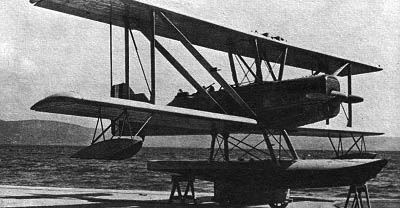
The antiquated Piaggio P.6 dated back 1927 (first flight) and was completely obsolete by 1934.
About Meridionali (IMAM)
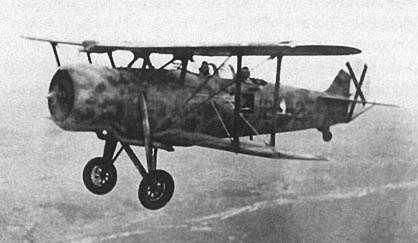
The Meridionali Ro.37 Lince (1933)
The Industrie Meccaniche Aeronautiche Meridionali, better known by the acronym “IMAM” was based in Naples and started production of airplanes from the 1920s to 1943. It was originally parto of the Società Anonima Officine Ferroviarie Meridionali owned engineer Nicola Romeo (yes, the founder of Alfa-Romeo) and started on new promising field of aviation in 1923. In 1925 production rights from Fokker were purchased for the first in-house production model called the Romeo Ro.1, a 2-3 seater reconnaissance/bombing biplane inspired by the C.V-E. The company also built parts for Fiat Aviazione and in 1927, a joint stock company was created to start production still under the IMAM brand.
The Ro.1 achieved success and recoignition in the colonial air force, but the company really started to shine with the Ro.37 and Ro.43 while the Ro.41 biplane became prevalent in flight schools of the Regia Aeronautica. The Ro.57 and its evolution Ro.58, despite being promising heavy twin-engine fighters were too hard to pilot for mass production, and arrived quite late. Also, the Ro.63 became the new reconnaissance and laison light model of the Regia Esercito and an “Italian Storch”, under licence from Fieseler. But again, the company failed to meet the high production rates asked for and only a few saw action before the armistice.
After WW2, IMAM became Aerfer and was purchased by the IRI Finmeccanica group, working notably on the first generation Italian jet fighter prototypes Sagittario and Ariete. In addition to the Ro.1 (still name after the founder, N. Romeo) and 1bis, the company produced the Ro.5, Ro.10, Ro.25, Ro.26, Ro.30 (all civilian models of short production), its greates success became the widespread IMAM Ro.37 Lynx multirole reconnaissance biplane widely used before and during WW2 (293 built), the mass-produced IMAM Ro.41 biplane fighter (1934, 743 built) retired gradually from 1940, the IMAM Ro.43 floatplane were are seeing here, the Ro.44 Octopus naval fighter, the Ro.45 (A remotorized version of the RO.37), the Ro.51, a 1st gen monoplane fighter prototype (1937), the Ro.57 twin-engine fighter (1943, 75 built) and its evolution the Ro.58 as well as the Ro.63 light reconnaissance model (6 built).
Context of the order
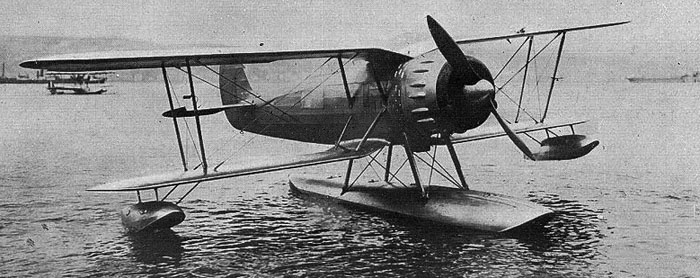
RO43 protoype
The Regia Marina evaluated in the early 1920s floatplanes to equip its new cruisers, and to overcome difficulties in using them in rough seas, catapults were designed to launch them, so the first models needed to be extra rugged to support the brutal take-off acceleration. The Regia Marina thus tested the Macchi M.18, Piaggio P.6 and CANT 25, but in 1933 a new specification was expressed for a new aircraft to replace all previous models. Top priorities were 240 km/h top speed, 600 km range or 5 h 30 min flight time. The competition was also attended by Rinaldo Piaggio’s P.18 and P.20, CMASA’s MF.10, Cantieri Riuniti dell’Adriatico’s CANT Z.504, Aeronautica Macchi’s C.76 and Meridionali. This was for the first round, sending only a paper proposal.
IMAM presented its project drawn by chief engineer Giovanni Galasso, which basically created a floatplane version of the Ro.37 bis, retaining common parts and still preserving performances while keeping the overall budget quite low thanks to commonality. The new model however was tailored with a gullwing configuration, central float and wing balancers. The designation Ro.43 was give, and the prototype first flew on November 19, 1934.
Winning the competition
The company IMAM (sometimes called Romeo) answered the called and proposed the Ro.43 as a catapult-launched reconnaissance aircraft, meeting criterias such as a speed of 240 km/h (149 mph), range of 600 km (370 mi) endurance of 5.5 hours. It won after a hard-fought competition against the Piaggio P.18/P.20 (in-house planned replacements for the P.6), the little known CMASA MF.10, and the always trusted CANT Z.504 and Macchi C.76. Romeo was mostly known for its land-based models and was the underdog of this competition.
To win, engineers choosed a floatplane derivative of their successful Ro.37 Lince, standard single-engine reconnaissance aircraft of the Regia Aeronautica, including during WW2. The Ro.43 first flew in 1934, built of steel tubes and wood covered by soft alloy and fabric. This two-seat biplane was caracterized by a folding gull upper wing, and an also folding inverse lower gull wing. It was only lightly armed but could fly at 300 km/h (185 mph) over 1,000 km (620 mi) range without a heavy load. Since it met the stringent Regia Marina’s specification requirements, the RO.43 won the competition.
In short, it took advantage of a lighter structure than its competitors to reach performance well above the original specifications. The Regia Marina’s commission signed a contract order to become standard equipment onboard all cruisers and the fleet as well as the four Litorrio class fast battleships in construction. Production began started at IMAM in 1935, with deliveries going on until 1941, with over 200 RO.43 being delivered to the Navy and coastal units.
Design issues and production
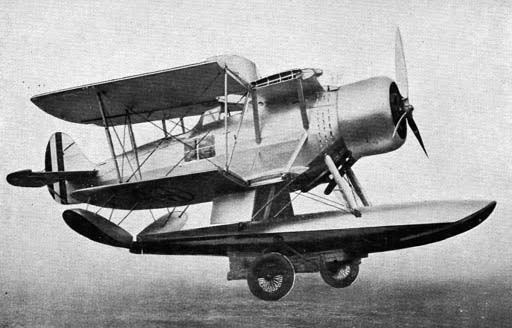
RO43 with folded wings
Still, the Ro.43 had some serious issues, due to its lightweight structure. It was too delicate for good handling at sea, and had poor sea-handling qualities. Although it was launched without much problems, it became standard issue, not to recover it at sea, forcing the pilot to search for the nearest land to land ashore, or river, lake. Each ship at least carried two, so that was supportable, but not tactically ideal. Though the Regia Marina already constrained by range issue was geared towards short sorties in strenght, basically interception missions, helped by the configuration of the peninsula for mid-Med control.
Afte the first prototype, numbered 244, delivered in novembre 1934, production started in April 1936 through November, with 23 delivered, which became the standard. CMASA plant also started production and delivered 22 also in July 1936 to January 1937, then April to Septemner 1937, 23 more. IMAM delivered two more batches of 23 in 1936 and 1937, 21 until April 1939, 3 in February, 18 in June, September that year, before production wartime setup and design modifications brought a doubling of the production of the second serie: 40 in October 1940 through May 1941 and 20 in June 1940 to September 1941 according to factory records.
Design
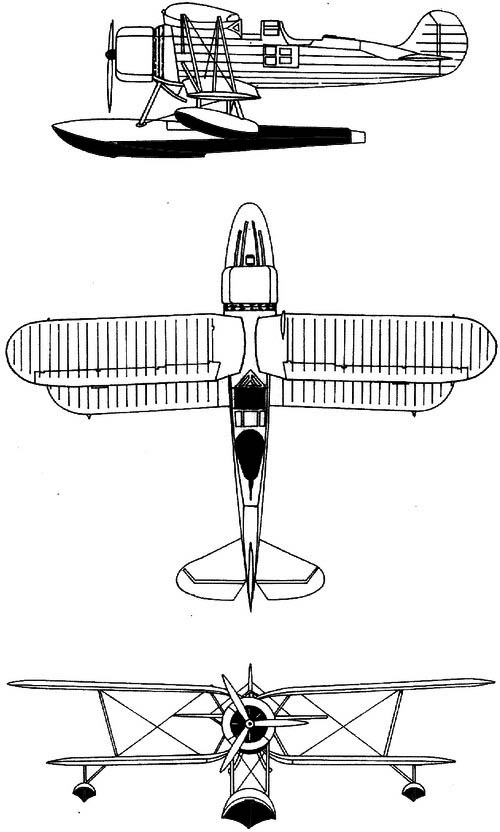
IMAM/Romeo Ro.43, 3-views
The Ro.37 structure and salient features were retained, and engineers worked on foldable wings single-engine and strenghtening its underside to be catapultable with an additional “strenght cell”. The fuselage was made of chromium-molybdenum steel tubes, welded and of rectangular section, plus lattice canvas walls. Lower spars carried attachments for the underwings floats. The upper struts connected the fuselage in its symmetry, forming a positive dihedral, offering the pilot ample visibility. This was the upper wing, different from the single, straight wing of the Ro.37.
The lower wings were connected with a negative vertical dihedral (inverted gull wing) to the fuselage bottom frames. They were hinged to be folded at the end of these angles. The tubes were assembled in longitudinal members of the upper and lower central shelves of the airframe. Those vertical were also part of the fuselage frame while the side walls were consisted of triangular mesh beam tubes. On the side of the fuselage, the observer’s seat was granted low-mounted windows with a sliding part and deflector for better downards visibility on either side.
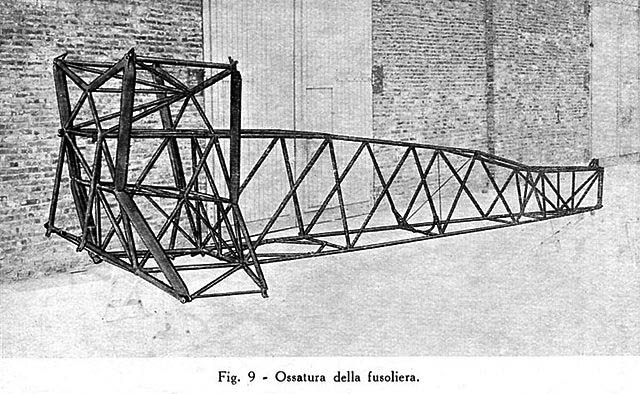
Tubular frame of the fuselage
The fuselage lining was interrupted forward as the upper halves were covered by duralumin sheating. The bottom was covered by chitonal canopies, supported by duralumin tube arches, easily removable. Their sides were held by a skeleton of spruce strips also fabric covered. The secondary structures supported various installations were made of aluminium sheating tubes, very light. The metal framing of the tail were cantilevered and stiffened by two high-strength steel profile wire tie rods, connecting the fixed deck spar to the upper end of the centreboard. Below were two chromium-molybdenum steel oval tubes. The tailplane had compensators, the fixed horizontal tail plane was adjustable on the ground.
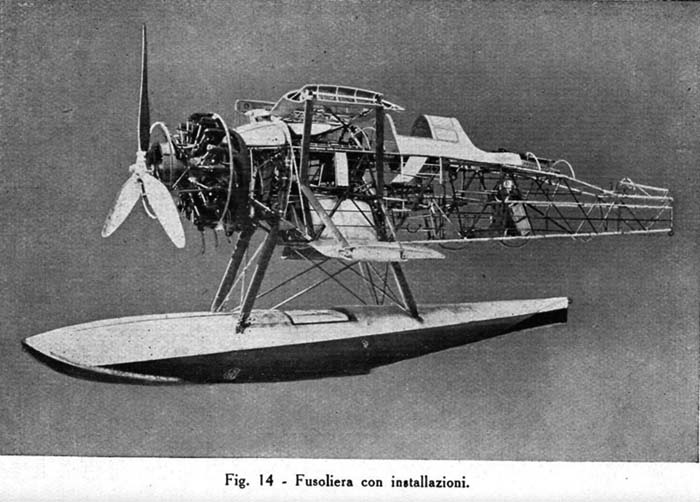
Fuselage assembly
The wing configuration rested on biconvex asymmetrical profiles which were foldable with positive scaling. These wings had a rectangular plan with a tapered connection in the ends. It was structured by spars in drawn duralumin tubes, connected by struts and crossbeams (high-strength steel wires) and divided into two half-wings and two central wing planes engaged with the fuselage, part of the structure. They were hinged by by means of cardan joints forming on either sides axes of rotation. Ribs were made of reticular wood, with a birch plywood core. They were canvas covered like the fuselage rear, treated and painted except for the leading edge, made in plywood for better strenght.
The central float was connected to the fuselage by a steel tube truss and crossbeams. It was woodedn-built and covered with waterproofed birch plywood (with arsonite and layers of canvas). It was subdivided into five watertight compartments with an inspection hatch on top and bottom with a lifting cap. Flotation was completed by the two underwing floats built the same way.
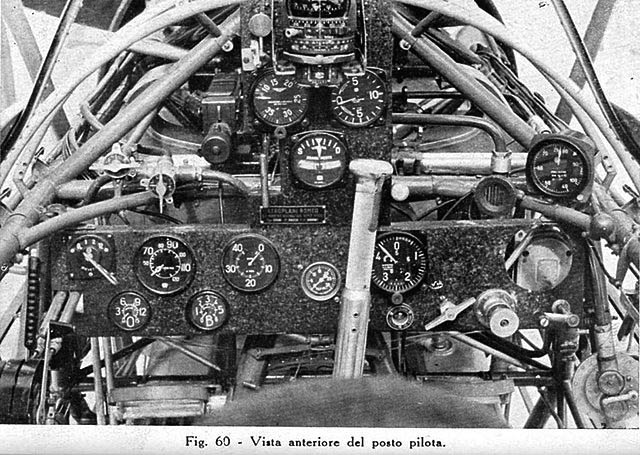
Cockpit
Engine & Performances
The RO.43 was powered by a Piaggio P.X R radial with 9 cylinders single star, air-cooled. It was equipped with a reduction gear and fan compressor. It was enclosed into a Magni-type cowling ring hood made of aluminum sheet. This engine was rated for 700 hp 700 hp (510 kW) at 2,350 rpm at 1000 m (). The 3.10 meters () three-bladed metal propeller had adjustable pitch on the ground.
The engine mount in chromium-molybdenum steel tubes was fixed to the fuselage by six bolts to the main tubular structure for easy removal and replacement. The fuel system comprised three aluminium tanks working by gravity for a total of 696 liters, one in the fuselage and the second, using pumps, in the main float. The third worked by gravity, in the central shelve above the pilot.
Crew & Equipments
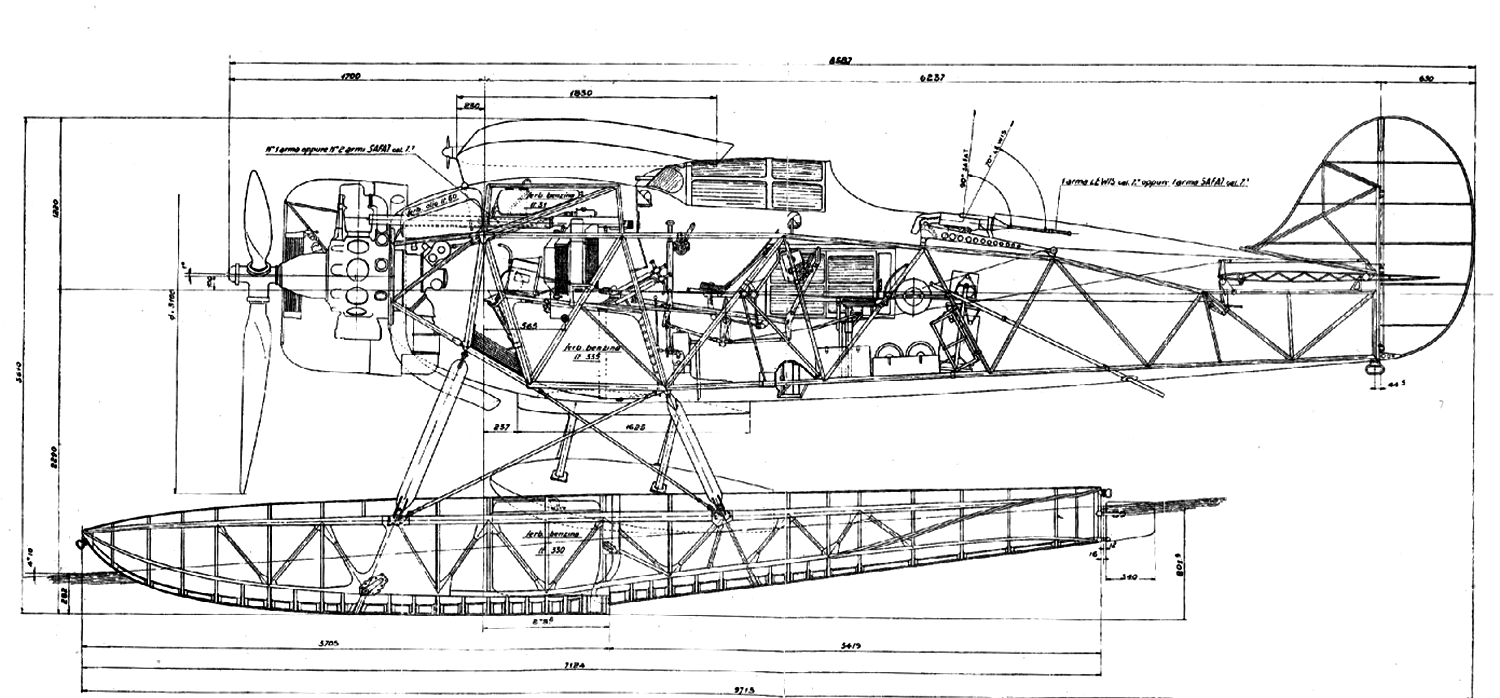
Plan of the Ro-43 showing the cockpit fully folded to cover the pilot. In reality it stayed almost always retracted as pilots wanted better visibility.
The crew was in open type cockpits the pilot froward having a small windshield but had two transparent side panels sliding between the windshield and the fixed rear roof, also protecting partially the gunner. These panels were independently adjustable in heigh to create a shelter and completely closing the pilot’s seat. It appears on early bleuprints. He also had an height-adjustable seat, as for the gunner, turned backwards, to face his observation windows, instruments, and defensive MG mount. The pilot also actioned a single machine gun forward in the fuselage.
The same gunner had access to a complete receiver/emitter radio system comprising the A.R.5 receiver and an R.A. 200-I transmitter with a shortwave dipole, placed between the lower wing and fuselage. Her also had a photographic gear, mounring an OMI type A.P.R.3 13×18 format objective, plus a camera. Both were fed by electricity through a dynamo fed a Grelli LD compressor to serve generators, including to power the radio in cased of engine shutdown after a forced ditching.
Armament
Armament comprised two 7,7 mm caliber Breda-SAFAT machine guns: One was fixed forward, located in the front fuselage to be handled indirectly by the pilot: It fired through the propeller disc. It could not therefore be maintained or operated in case of jamming by the pilot in flight.
The second one was defensive, on a pivoting ring-arm on a support aft, manned with hydraulic control by the observer/gunner. In the first models, there was a Lewis MG and Romeo turret, often replaced later by a Breda-SAFAT on a flexible mount, which became standad during production. 500 rounds were carried in a magazine, belt-fed for the fuselage one, 500, also belt-fed, aft. Engineers planned to install two MGs forward but it never came to fruition.
The RO.43 was already taxed by the weight of its floats, and thus, was not design to carry any extra payload, bomb or depht charge.
Detailed specs
_MI_-_AA.VV-16.jpg)
Folding wings scheme
Specs |
|
| Crew: | 2: Pilot, Rear observer/gunner |
| Fuselage Lenght | 9.71 m (31 ft 10 in) |
| Wingspan | 11.57 m (38ft 10in) |
| Height | 3.51 m (11ft 6in) |
| Empty weight: | 1,776 kg (3,916 lb) |
| Gross weight: | 2,400 kg (5,291 lb) |
| Powerplant: | Piaggio PXR 9-cyl. AC radial engine, 522 kW (700 hp) |
| Propellers: | 3-bladed fixed-pitch propeller |
| Maximum speed: | 300 km/h (190 mph, 160 kn) |
| Cruise speed: | 250 km/h (160 mph, 130 kn) |
| Alighting speed: | 103 km/h (64 mph, 56 kn) |
| Endurance: | 4½ up to 8½ hours |
| Range: | 192 km with 640 kgs load at 2300 m |
| Service ceiling: | 6,600-7,200 m (22,000 ft) |
| Armament – Guns | 2x 7.5 mm (.303 in) Breda-SAFAT machine guns, fuselage and defensive. |
| Armament – Bombs | None |
Operations
Italian Use
The Ro.43 was gradualy delivered to the Regia Marina in groups of two per unit, to the late light cruisers of the Montecuccoli, Duca D’Aosta and Duca degli Abruzzi, after some proving tests from the seaplane carrier Giuseppe Miraglia. Operating conditions soon highlighted that good performances were paid by structural fragility when landing, hoist them back on board and wearing down to structural failure and damage resulting in many of these operations over time, sometimes rapid. The operational capacity was hindered and since no alternative existed, it became standard issue to dispose them, not recovered; ater a mission. These were in service on the early heavy cruiser trio (Trento, Trieste, Bolzano) and well as the four Zara class on their forward catapult, and the six late group Condotierri (amidships catapult), or the earlier four Giussano, Barbiano, Colleoni, Bande Nere (forward catapult, but they are not seen in photos but only earlier models), and the Group II Luigi Cadorna, Armando Diaz on a rear catapult. Also the battleships Litorrio and later Vitorio Veneto and Roma carried three aft, on a stern axial catapult.
When WW2 started, the Ro.43 was quickly converted by IMAM as embarked fighter for the Littorio Class, and also it was hoped to have one RO.44 and one Ro.43 on the Zara Class, and others ships having pairs, but with only two 7.7 mm Breda-SAFAT machine guns forward, they were weak opponents. Structural deficiencies and intense use urged an improved version which became the RO.44, which was not agile or fast enough as a fighter and like the RO.44 was used for reconnaissance, observation, and artilery spotting.
Re-boarding operations using the sling process entirely depended on the pilot and captain’s respective skills as cooperative weather conditions. With too much contraty factors after a mission, pilots just aimed at the nearest coast. This led to a deficit in intel, which proved decisive at the battle of Cape Matapan. A solution was the conversion of the Reggiane Re.2000 (see later), but few were avilable, forcing the Ro.43 to soldier on until the armisitice of 1943, where 48 were still in service, 19 embarked, 20 in coastal Regia Marina Squadrons.
Spanish Use
Spanish use did not started during the civil war. In fact, it was linked to the 8 September armistice, as eight Ro. 43 left La Spezia to Sardinia, and from there, took refuge in La Maddalena. The German attack led to the occupation of the arsenal and two Ro.43 were shot down while attempting to take of to avoid capture. The others made it in the Baleares. They were interned by the Spanish Air Force and in late 1944, acquired by Spain as “HR.7” and used only by the II Escuadrilla, 51 Regimento de hidros, until 1951.
Soldiering without replacement
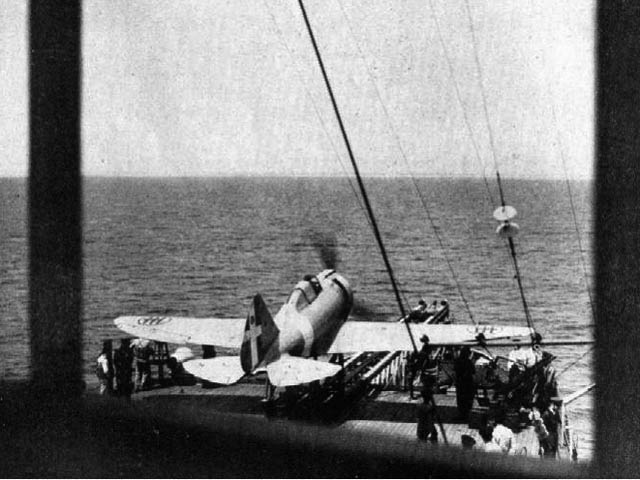
Although it was clear in 1941, when production stopped, that the RO.43 was made obsolete by new monoplanes, replacement was never to arrive in time. Production for the Regia Aeronautica was focused on more urgent models, and since the Ro.43’s own poor sea handling qualities were a main issue, it was decided to adopt a more radical approach: The Regia Marina would adopt as an interim measure a catapult launched Re2000 fighter, usable to carry bombs and even aerial torpedoes. It was planned to be used from capital ships. First tests were performed on May 1942 from the seaplane carrier Giuseppe Miraglia. From September the definitive Re.2000 IIIa Serie “Catapultabile” was adopted by the Aviazione Ausiliaria per la Regia Marina and deployed to the Littorio class battleships.
Main variant: Ro.44 Octopus fighter
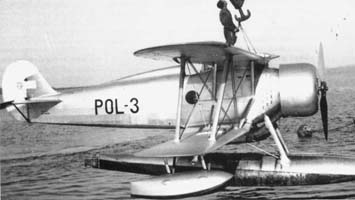
Photo of one of the initial RO-44 in service, hoisted by a boom back onto a catapult. MM3694 POL-3, flight school of Pola-Puntisella.
Although the role of the sea fighter (floatplane) gradually lost importance due to increased performances of land-based model the Regia Aeronautica’s ministry decided in 1931 to support the Regia Marina against air attacks by a single unit, the 88th Autonomous Caccia Marittima Group based in Vigna di Valle, equipped by then with an old mix Fiat C.R.20 Idro and Macchi M.41bis. Soon, the Regia Marina issued a specification for a catapultable observation model, won by IMAM with the Ro.43, nentering service in 1935. It had good performances and so IMAM, headed by engineer Galasso started development of more rugged and better armed model usable both as fighter and as replacement to the Ro.43.
Galasso however left the project almost unchanged with modifications of the fuselage and removing the observer’s post, redesigning the back down to the tail, modernizing the radio system and fitting a new armament forward, with two 12.7 mm (0.5 in) Breda heavy machine. The prototype pf the RO.44 made its maiden flight in October 1936, piloted by Nicolò Lana. Fight tests concluded it had even better handling characteristics but but tom speed speed still 60 km/h lower than the Fiat C.R.32 Idro. It still had an overwhelmingg community of parts with Ro.43 and this lower cost, facilitated maintenance while the Ro.43 could be converted as as a dual-control training model.
The Ministry decided to maintain the specialty of maritime fighter with 4 squadrons already filled with existing models, and thus, ordered only 51 RO.44 in replacement of the older 88th Group C.R.20 I and M.41bis, with CANT 25 kept for training. The order was further reduced to 35 aircraf, delivered by IMAM in two batches or 30 and 5, ending by February 1937.
The RO.44 soon nicknamed “Octopus” was soon helping in operations for the axis reconquest of Crete in 1941, used for ground strafing actions. However its performances to that point relegated it as a trainer for the seaplane schools of the Regia Aeronautica, and the fate of the remainder by late 1943 is uncertain. Technically it shared the same airframe and features, tubular structure, removable duralumin canopies, open cockpit with windshield, same tail, floats, and engine. Apart the redesigned aft part of the fuselage, behind the pilot, some weight gains and better speed, the major difference was the placement of the two 12.7 mm Breda-SAFAT heavy machine guns positioned in the forward fuselage, in front of the pilot, which had a new telescope collimator. Like the former LMG on the RO.43, they fired through the propeller arc thanks to an interruptor gear.
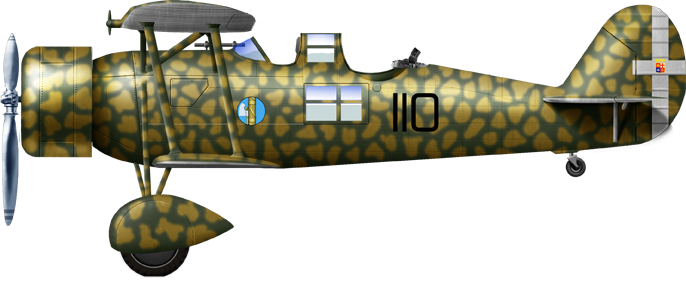
IMAM RO37 bis, the basis for the design.
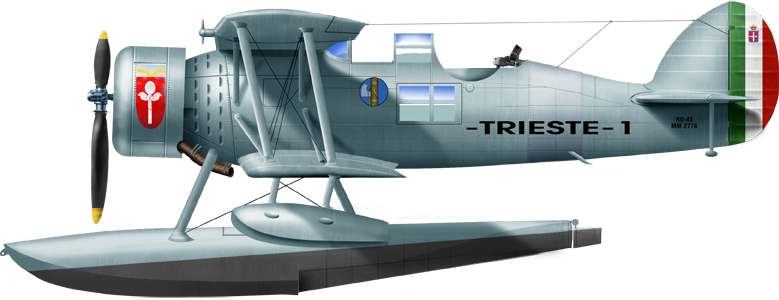
RO-43 on the cruiser Trieste, 1936; It is numbered 1, the cruiser carried two of them.
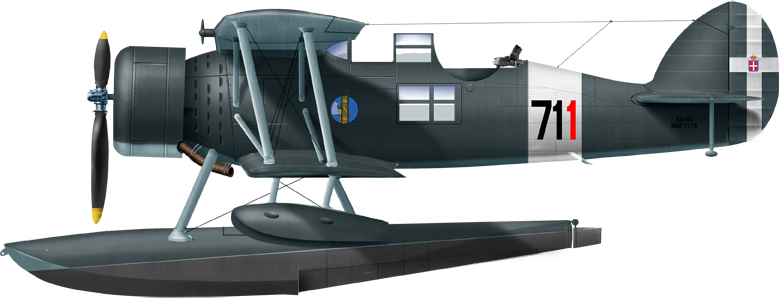
RO-43 of the 71st Squadiglia, Regia Marina, 1940
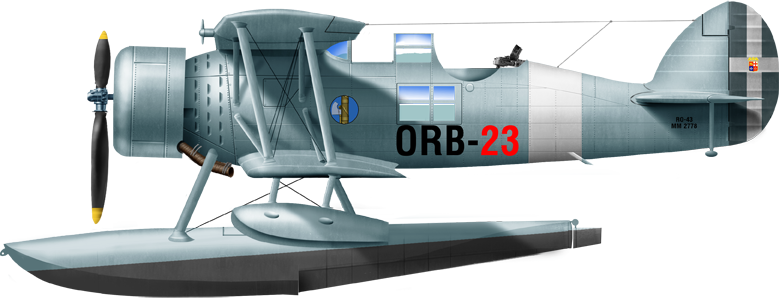
Ro 43 Scuola Idroricognizione di Orbetello 1942
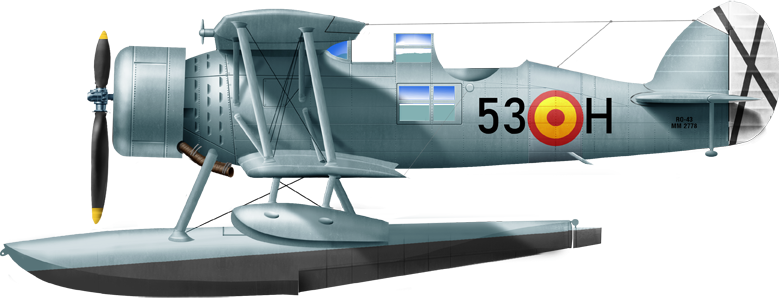
Spanish 1st Escuadra Grupo 53, 51th Regimento, Baleares, 1944.
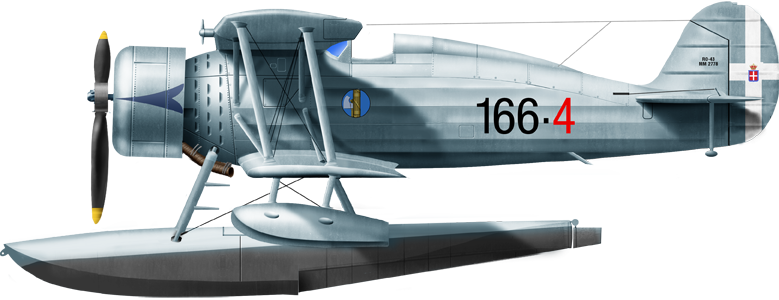
RO-44 Octopus Naval Fighter (1938)
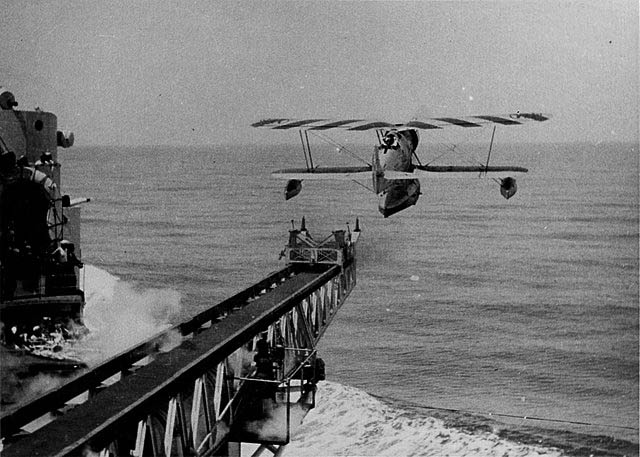
RO43 catapulted
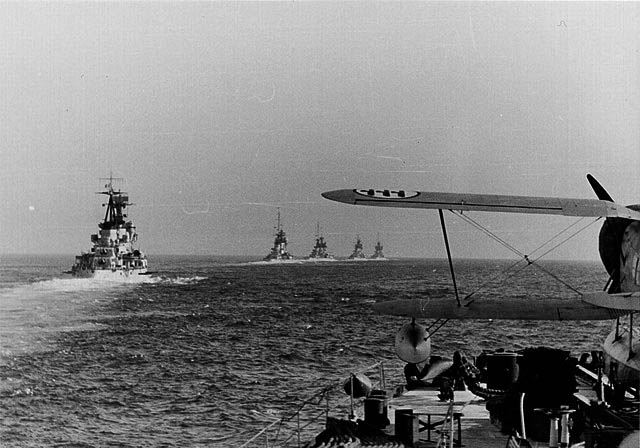
RO43 on catapult
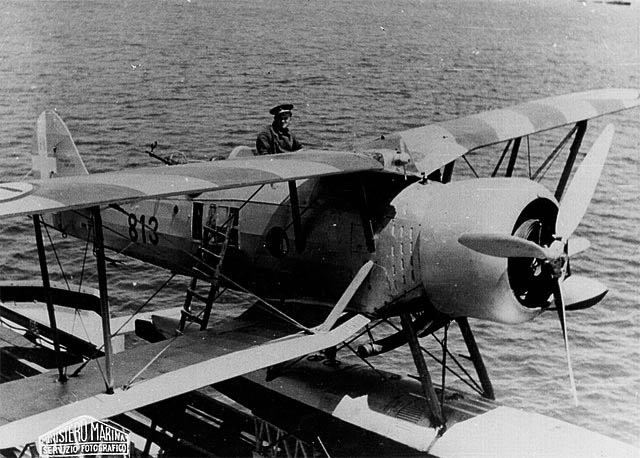
Phyrexian coll. Marina Militare, RO43 hoisted by a boom back to the cruiser carrier.
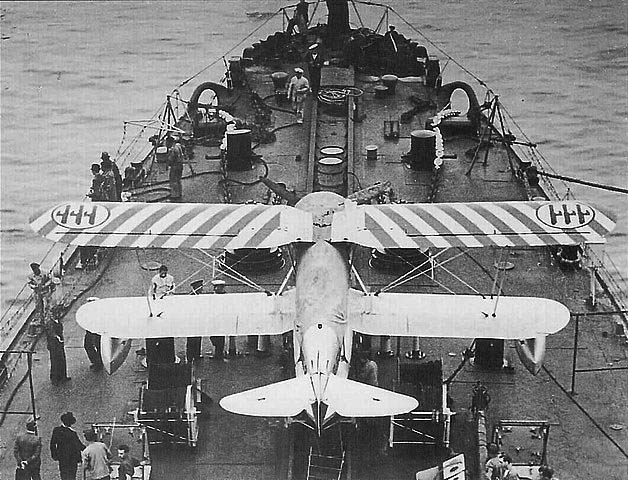
RO43 from the cruiser Zara
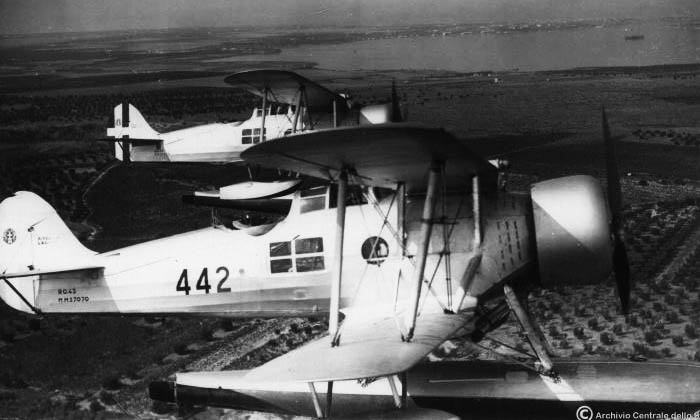
Ro43 based on the cruiser Armando Diaz
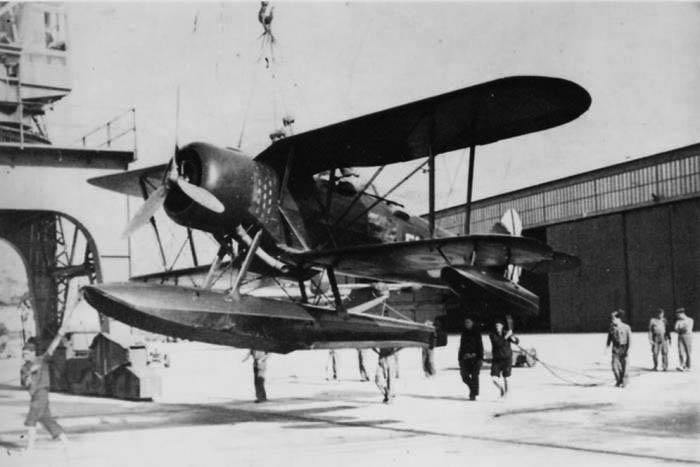
Spanish Ro.43
RO.43 now preserved in Italy
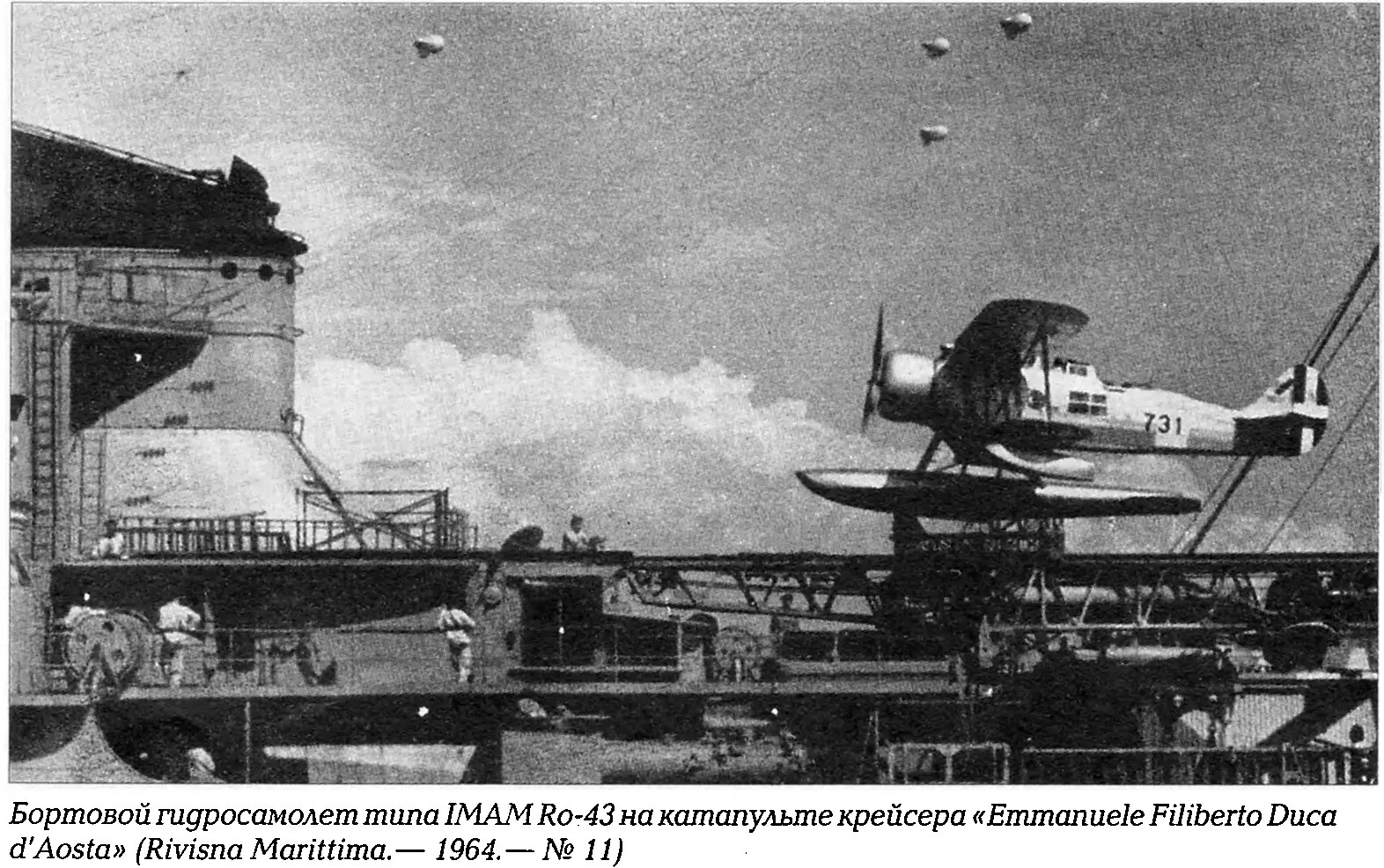
Ro43 Emanuele Filiberto Duca D’Aosta
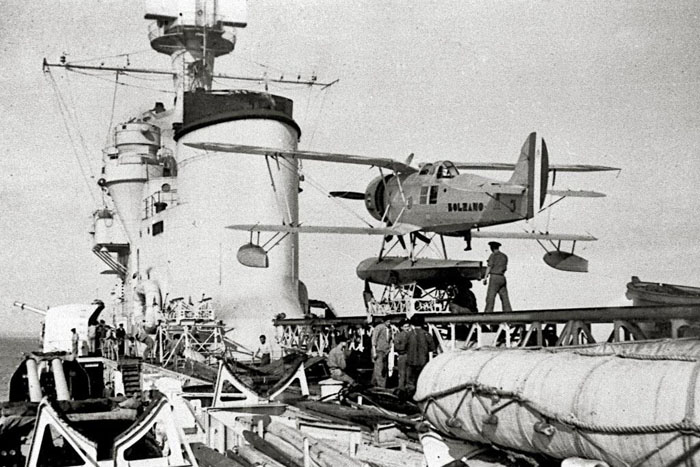
Ro43 on Bolzano
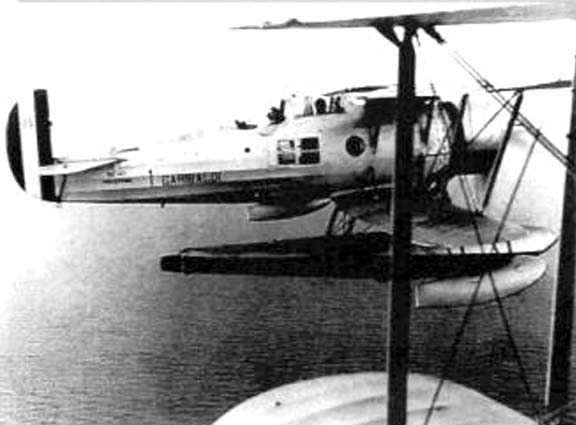
IMAM Ro.43 cruiser Garibaldi
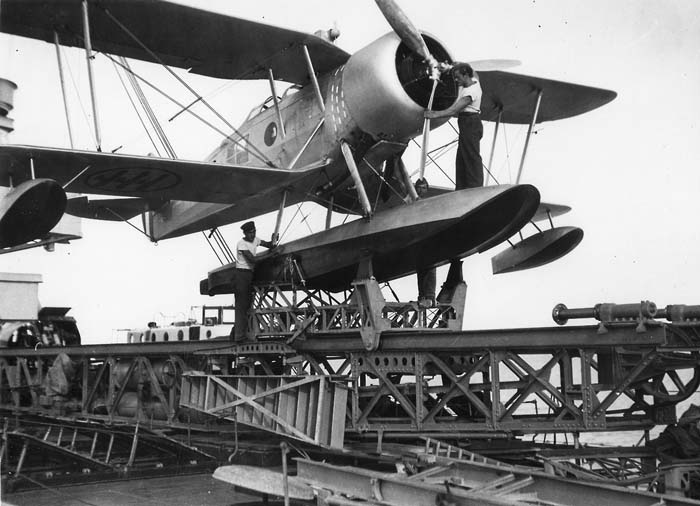
Ro43 catapult serviced
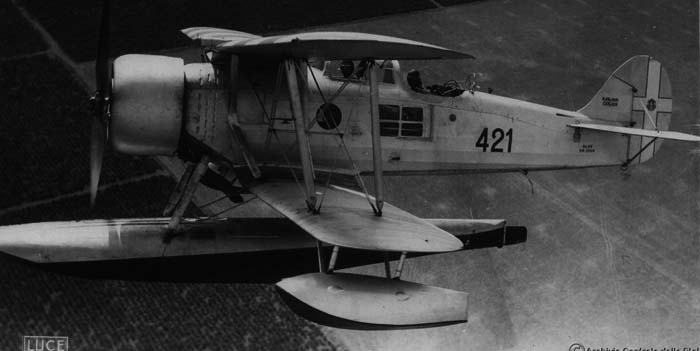
Ro43 in flight
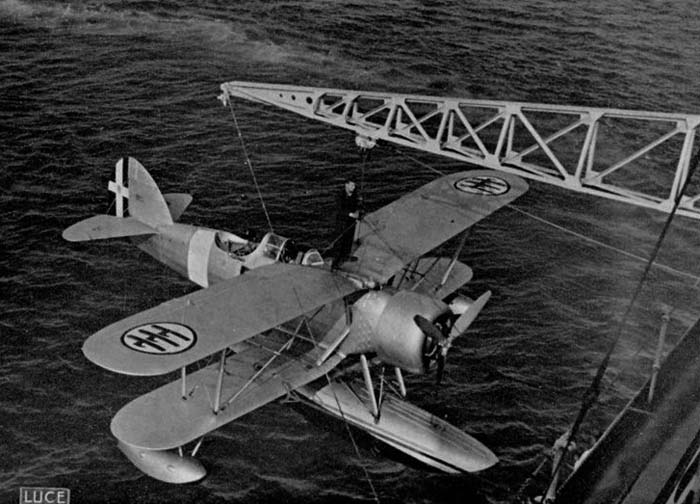
Ro43 hoisted up
Read More and Sources
books
Main: Ministero dell’Aeronautica Direzione Generale delle costruzioni e degli approvvigionamenti Idronavale Ro.43 (motore Piaggio P.X.R) S.A. Industrie Aeronautiche Romeo Napoli Istruzioni per il montaggio e la regolazione (24 feb. 1937).
Enzo Angelucci, Paolo Matricardi, Guida agli Aeroplani di tutto il Mondo (Vol.3), Milano, Arnoldo Mondadori Editore, 1979.
Giorgio Apostolo, Guida agli Aeroplani d’Italia dalle origini ad oggi, Milano, Arnoldo Mondadori Editore, 1981.
Achille Boroli, Adolfo Boroli, L’Aviazione (Vol.9), Novara, Istituto Geografico De Agostini, 1983.
Tullio Marcon, Ali d’Italia 12 – IMAM Ro 43/44, Torino, La Bancarella Aeronautica, 1999.
Daniele Lembo, Le portaerei che non salparono, Roma, IBN Editore, 2016
Leo Marriott, Catapult Aircraft, Barnsley, Pen & Sword Aviation, 2006
Dimensione Cielo – Bombardieri, vol. 4, Roma, Edizioni Bizzarri
Tullio Marcon, Ali d’Italia 12 – IMAM Ro 43/44, Torino, La Bancarella Aeronautica
Sulle ali dei Romeo, in Rivista Aeronautica, n. 1, Roma, Stato Maggiore Aeronautica, 2012
Tullio Marcon, I velivoli catapultabili in guerra (1939-1945), Storia Militare, n. 9
Portaerei: 30 anni di storia, in Rivista Marittima, Roma, Stato Maggiore Marina, febbraio 2019.
Decio Zorini, I Catapultabili della Regia Marina, in Centenario dell’Aviazione Navale 1913
links
Archive, on the RO.44
The RO.43 on airwar.ru
The RO.44 on airwar.ru
avioblog.it
pro-samolet.ru
historyopinion.com Kerch
cmpr.it
culturanavale.it
aviastore.it
avionews.it
alchetron.com
On warthunder
www.wardrawings.be – Ro43
wiki IMAM Ro 37 It
wiki IMAM
Model Kits

Scalemates Query – About 10 kits 1:48 or 1:72 and a few 1:350 or 1:700 for ships modellers.


 Latest Facebook Entry -
Latest Facebook Entry -  X(Tweeter) Naval Encyclopedia's deck archive
X(Tweeter) Naval Encyclopedia's deck archive Instagram (@navalencyc)
Instagram (@navalencyc)





 French Navy
French Navy Royal Navy
Royal Navy Russian Navy
Russian Navy Armada Espanola
Armada Espanola Austrian Navy
Austrian Navy K.u.K. Kriegsmarine
K.u.K. Kriegsmarine Dansk Marine
Dansk Marine Nautiko Hellenon
Nautiko Hellenon Koninklije Marine 1870
Koninklije Marine 1870 Marinha do Brasil
Marinha do Brasil Osmanlı Donanması
Osmanlı Donanması Marina Do Peru
Marina Do Peru Marinha do Portugal
Marinha do Portugal Regia Marina 1870
Regia Marina 1870 Nihhon Kaigun 1870
Nihhon Kaigun 1870 Preußische Marine 1870
Preußische Marine 1870 Russkiy Flot 1870
Russkiy Flot 1870 Svenska marinen
Svenska marinen Søværnet
Søværnet Union Navy
Union Navy Confederate Navy
Confederate Navy Armada de Argentina
Armada de Argentina Imperial Chinese Navy
Imperial Chinese Navy Marinha do Portugal
Marinha do Portugal Mexico
Mexico Kaiserliche Marine
Kaiserliche Marine 1898 US Navy
1898 US Navy Sovietskiy Flot
Sovietskiy Flot Royal Canadian Navy
Royal Canadian Navy Royal Australian Navy
Royal Australian Navy RNZN Fleet
RNZN Fleet Chinese Navy 1937
Chinese Navy 1937 Kriegsmarine
Kriegsmarine Chilean Navy
Chilean Navy Danish Navy
Danish Navy Finnish Navy
Finnish Navy Hellenic Navy
Hellenic Navy Polish Navy
Polish Navy Romanian Navy
Romanian Navy Turkish Navy
Turkish Navy Royal Yugoslav Navy
Royal Yugoslav Navy Royal Thai Navy
Royal Thai Navy Minor Navies
Minor Navies Albania
Albania Austria
Austria Belgium
Belgium Columbia
Columbia Costa Rica
Costa Rica Cuba
Cuba Czechoslovakia
Czechoslovakia Dominican Republic
Dominican Republic Haiti
Haiti Hungary
Hungary Honduras
Honduras Estonia
Estonia Iceland
Iceland Eire
Eire Equador
Equador Iran
Iran Iraq
Iraq Latvia
Latvia Liberia
Liberia Lithuania
Lithuania Mandchukuo
Mandchukuo Morocco
Morocco Nicaragua
Nicaragua Persia
Persia San Salvador
San Salvador Sarawak
Sarawak Uruguay
Uruguay Venezuela
Venezuela Zanzibar
Zanzibar Warsaw Pact Navies
Warsaw Pact Navies Bulgaria
Bulgaria Hungary
Hungary

 Bundesmarine
Bundesmarine Dutch Navy
Dutch Navy Hellenic Navy
Hellenic Navy Marina Militare
Marina Militare Yugoslav Navy
Yugoslav Navy Chinese Navy
Chinese Navy Indian Navy
Indian Navy Indonesian Navy
Indonesian Navy JMSDF
JMSDF North Korean Navy
North Korean Navy Pakistani Navy
Pakistani Navy Philippines Navy
Philippines Navy ROKN
ROKN Rep. of Singapore Navy
Rep. of Singapore Navy Taiwanese Navy
Taiwanese Navy IDF Navy
IDF Navy Saudi Navy
Saudi Navy Royal New Zealand Navy
Royal New Zealand Navy Egyptian Navy
Egyptian Navy South African Navy
South African Navy






























 Ukrainian Navy
Ukrainian Navy dbodesign
dbodesign